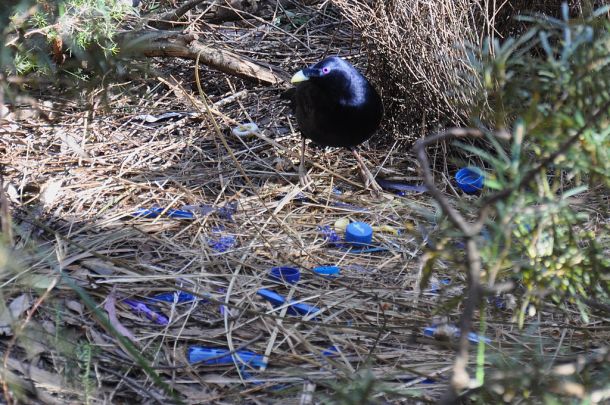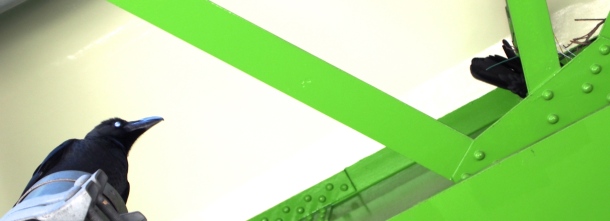Crows in Japan (Corvus macrorhynchos) show their resourcefulness by substituting clothes hangers for sticks as nest building materials in a commercial part of downtown Tokyo.
—
The trend of urbanization hasn’t decelerated and humans continue to develop rural areas and forests into small towns or cities. All this land transformation means we are also robbing animals of their natural habitats. Most animals that live on or below ground had no choice but to abandon their homes once the bulldozers arrived. Small size, wings and inconspicuous dwellings or nests built high above ground seem to be key advantages for surviving in urban areas – we still see insects and birds around. Overtime, the birds and insects adapted to urban environments and some even started to incorporate man-made materials in their lives.
Satin Bowerbirds (Ptilonorhynchus violaceus) are widely studied for their courtship and bower building behaviour. Birds are generally endowed with colourful plumage, elaborate songs, or impressive dance, which they use to attract mates. Sadly, the male Satin Bowerbird’s call and dance is often interpreted as a threat by the female Satin Bowerbird and they lack bright coloured feathers. In attempt to attract female Satin Bowerbirds, they invest heavily in their bowers – decorating them with colorful items, including plastic pegs, caps and straws. More mature males tend to use more blue coloured objects.

Photograph sourced from Wikipedia
While the male Satin Bowerbird uses plastic for purely aesthetic reasons, bees have found more practical uses for it. The Alfalfa Leaf-cutter Bee (Megachile rotundata) and Bellflower Resin Bee (Megachile campanulae) typically use cut plant leaves or plant and tree resins to build their nests. But in urban areas where there may be limited availability of such materials, researchers found that the Megachile bees also collect polyurethane and polyethylene plastics as novel nest materials.
The Megachile bees aren’t the only ones being resourceful. Crows in Japan have also found ways to use man-made materials to their benefit. Crows were spotted bringing metal and plastic clothes hangers to use as building materials for their nest under the elevated train tracks of the Yamanote line in Ikebukuro. This is hardly surprising as crows have been known to craft hooks to support their foraging activities and even solve tests taken straight from Aesop’s fables. However, it is unclear whether they are using clothes hangers as nest materials due to lack of sticks and twigs in the area or because they’ve found, through the process of trial and error, that clothes hangers are a superior alternative. Either way, if they find the clothes hangers to be a good substitute, they’ll probably use more of it – until people catch on and stop hanging clothes on balconies or stop using light weight clothes hangers altogether.



These photographs were taken under the elevated tracks of the Yamanote line in Ikebukuro in April. A crow was spotted flying towards the nest while carrying a metal clothes hanger in its beak and was later joined by a partner. Coincidentally, crows are known to build their nests in forks of trees and the green metal slabs in the photograph resemble a split of a tree fork – metal trees with metal nests, how fitting.
-end-
Check out my book about Japanese crafts:
Kindle e-book: Crafting in Japan – Exploring Japanese crafts through studio visits!
![Crafting in Japan: Exploring Japanese crafts through studio visits by [Florence Lui-King]](https://m.media-amazon.com/images/I/51EYayho1pL.jpg) Summary: Crafting in Japan: Exploring Japanese Crafts Through Studio Visits uses beauty and craftsmanship as a springboard to delve deeper into intriguing aspects of traditional Japanese crafts: heritage, cultural history, and science/engineering. The sustainable materials used and the making processes that transform them into works of fine craftsmanship represent the resourcefulness, creativity, and dedication that artisans have displayed through the ages.
Summary: Crafting in Japan: Exploring Japanese Crafts Through Studio Visits uses beauty and craftsmanship as a springboard to delve deeper into intriguing aspects of traditional Japanese crafts: heritage, cultural history, and science/engineering. The sustainable materials used and the making processes that transform them into works of fine craftsmanship represent the resourcefulness, creativity, and dedication that artisans have displayed through the ages.
The chapters of the book tell the stories of the crafts through studio visits, conversations with artisans in Japanese, and the author’s experience living in Japan as a maker and collector of crafts. Each chapter showcases photographs taken at the artisanal workshops to complement the text.
The book also traces a broader narrative. The government is eager to preserve the craft forms because they represent cultural heritage that date back to the classical era. Many artisans are affiliated with studios that were established in the late Edo or Meiji Period, when the domain system of feudal Japan dissolved upon the adoption of the free market system. Perhaps most intriguing of all is how each craft form draws out different aspects of Japan’s rich cultural history despite charting the same timeline.